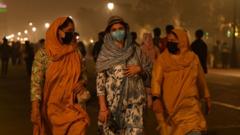While severe air pollution plagues cities like Delhi, narrative representations in Indian films and literature remain scarce. Experts argue this gap fails to communicate the realities of climate change to the public, though some documentaries are beginning to address the issues. Challenges persist in creating engaging yet meaningful stories about pollution that reach wider audiences.
The Silence of the Smog: India's Struggle with Air Pollution in Pop Culture

The Silence of the Smog: India's Struggle with Air Pollution in Pop Culture
India's air pollution crisis is curiously absent from mainstream cinema and literature, despite being a significant public concern.
In the film Pink, Amitabh Bachchan’s character emerges from a haze of smog, mask in place, emblematic of the environmental crisis affecting Delhi and other cities in India. Yet despite such depictions, the serious issue of air pollution has not inspired the same cultural response seen with environmental disasters like floods. Siddharth Singh, author of The Great Smog of India, calls the lack of engagement an "enormous failure." He points out that while academia examines pollution, connecting it to public narratives proves challenging due to scientific jargon that eludes most people.
Amitav Ghosh, a noted author, echoes Singh's sentiment, commenting on people’s unsettling normalcy regarding climate change. His observation during a heatwave in India, where alterations to the environment trigger little reaction, reinforces the gradual yet damaging effect of climate change—a slow violence that renders the topic hard to visualize and write about.
Documentaries like All That Breathes, directed by Shaunak Sen, move beyond conventional storytelling, connecting personal narratives with broader environmental issues. Showcasing two brothers who rescue black kites from the smoggy skies of Delhi, Sen frames pollution as the backdrop for human interrelationships, inviting audiences to consider the interconnectedness of their lives with climate change.
In contrast, filmmaker Nila Madhab Panda believes that while art can drive impact, it requires entertainment value to engage broader audiences effectively. His court drama, Megha's Divorce, illustrates the struggles of a couple torn between leaving or staying in pollution-heavy Delhi. Despite the grim reality of pollution statistics depicting millions affected annually, finding personal stories to humanize this crisis remains a hurdle for creators.
The literary landscape is more diverse, with regional literature often tackling environmental themes. Yet contemporary English narratives have yet to fully embrace these issues. Observations from Singh suggest privilege insulates storytellers, who are often disconnected from the realities faced by those living near polluted areas.
Memes and digital content have emerged as popular tools for engagement, conveying the absurdity of life amid pollution. A notable meme poking fun at visibility issues in the polluted air highlights the creative wave that, hopefully, will spark a more significant narrative shift among decision-makers.
While society's collective response to air pollution may currently be muted, experts like Singh are optimistic that grassroots creative expressions will ignite a much-needed dialogue, paving the way for impactful change in how environmental issues are represented in Indian culture.


















